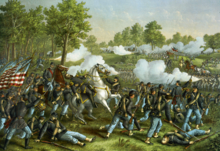Wilson's Creek National Battlefield
| Wilson's Creek National Battlefield | |
|---|---|
 | |
| Location | Greene County, Missouri, USA |
| Nearest city | Republic, Missouri |
| Coordinates | 37°6′56″N 93°25′12″W / 37.11556°N 93.42000°W |
| Area | 2,433 acres (9.85 km2)[1] |
| Established | April 22, 1960[2] |
| Governing body | National Park Service |
| Website | Wilson's Creek National Battlefield |
Wilson's Creek National Battlefield | |
| NRHP reference No. | 66000113[3] |
| Added to NRHP | October 15, 1966[3] |
Wilson's Creek National Battlefield, located near
Battle at Wilson's Creek

In early 1861,
Meanwhile, Price had been reinforced by a small Confederate army under the command of Benjamin McCulloch. On August 10, Lyon decided to attack Price and McCulloch's combined forces while the Confederate were encamped along the banks of Wilson's Creek. Lyon split his outnumbered forces into wings commanded by himself and Col. Franz Sigel in order to attack the Confederate camp from both the front and the rear. Sigel's force was soon driven from the field, allowing Price and McCulloch to combine their forces against Lyon's column, which had taken position on Bloody Hill. Lyon was killed, and the Union forces retreated from the field.[5] It was the first major military engagement in the American Civil War to take place west of the Mississippi river.[6]
After the battle, Price and McCulloch strongly disagreed over command issues. Price would move towards
Park history
The battle site was established as Wilson's Creek National Battlefield Park on April 22, 1960,
The park is located near Republic, Missouri, which is southwest of Springfield in Greene County, Missouri.[3] The American Battlefield Trust and its partners have acquired and preserved 278 acres (1.13 km2) of the battlefield, most of which has been sold to the National Park Service and incorporated into the park.[15] In total, the park preserves 1,750 acres of the battlefield.[16]
Features
Wilson's Creek National Battlefield is open seven days a week from 8 a.m. to 5 p.m. The visitor center contains exhibits about the battle, a short film, fiber optic maps and a bookstore. The battlefield is accessed by a five-mile long self-guided automobile-tour loop, which connects eight stops highlighting historically important facets of the battlefield.[17] The tour loop also features hiking trails and a seven-mile long horseback riding trail.[18] On August 10, the anniversary of the battle, the park hosts commemorative events.[18]

The Ray House, which is still preserved on the battlefield, dates to before the Civil War, and was used as a field hospital following the battle. General Lyon's body was brought to the Ray House by Confederate soldiers after the Union army retreated from the field. The house is open for tours during limited hours over the summer.
The battlefield also includes several features besides those on the tour road. One of these is the John K. and Ruth Hulston Civil War Research Library, which was founded in 1985.
Newtonia
The Mathew H. Ritchey House and 25 acres of battlefields of the First Battle of Newtonia and Second Battle of Newtonia including the Old Newtonia Cemetery in Newtonia, Missouri, about 45 miles away, were added to Wilson's Creek National Battlefield in 2022 by the Consolidated Appropriations Act, 2023, despite National Park Service opposition due to the lack of connection, need for protection, or enhancement of public enjoyment.[22][23]
References
- ^ "Listing of acreage – December 31, 2020" (XLSX). Land Resource Division, National Park Service. Retrieved August 15, 2021. (National Park Service Acreage Reports)
- ^ "Park Anniversaries". Retrieved August 13, 2021.
- ^ a b c Thomas P. Busch (March 1976). "National Register of Historic Places Inventory Nomination Form: Wilson's Creek National Battlefield" (PDF). Missouri Department of Natural Resources. Retrieved January 1, 2017. (includes 3 photographs from 1969, 1975)
- ^ Stevens 1990, pp. 285–286.
- ^ "A Brief Account of the Battle of Wilson's Creek". National Park Service. Retrieved January 31, 2020.
- ^ Prushankin, Jeffrey S. "The Civil War in the Trans-Mississippi Theater 1861-1865" (PDF). history.army.mil. United States Army. Retrieved January 30, 2020.
- ^ Piston & Hatcher 2000, pp. 312–314.
- ^ Piston & Hatcher 2000, pp. 314–316.
- ^ Kennedy 1998, pp. 34–37.
- ^ "Senate Report - Wilson's Creek National Battlefield". govinfo.gov. United States Government Publishing Office. Retrieved January 30, 2020.
- ^ "Public Law 91-554" (PDF). govinfo.gov. United States Government Printing Office. Retrieved January 31, 2020.
- ^ "Greene County National Register Listings". dnr.mo.gov. Missouri Department of Natural Resources. Retrieved January 30, 2020.
- ^ "US Public Law 108-394" (PDF). congress.gov. United States Government Printing Office. Retrieved January 30, 2020.
- ^ Skalicky, Michele (February 14, 2018). "Significant Historical Site Added to Wilson's Creek National Battlefield". KSMU Ozarks Public Radio. Retrieved March 25, 2020.
- ^ "Saved Land 2019". battlefields.org. American Battlefield Trust. Retrieved January 31, 2020.
- ^ Kennedy 1998, p. 23.
- ^ "The National Parks Index 2009–2011" (PDF). National Park Service. Retrieved March 25, 2020.
- ^ a b c "Things To Do - Wilson's Creek National Battlefield (U.S. National Park Service)". www.nps.gov. Retrieved October 4, 2017.
- ^ "Teacher's Guide for Bloody Hill" (PDF). National Park Service. Retrieved March 22, 2020.
- ^ a b "The Hulston Library - Wilson's Creek National Battlefield (U.S. National Park Service)". www.nps.gov. Retrieved January 31, 2020.
- ^ "Visit the Wilson's Creek National Battlefield". Wilson's Creek National Battlefield Foundation. Retrieved October 4, 2017.
- ^ "S. Rept. 117-185 - Wilson's Creek National Battlefield Addition". Congress.gov. October 18, 2022.
- ^ Ostmeyer, Andy. "Fight to preserve Newtonia continues, but with new sense of urgency". Joplin Globe. Retrieved December 28, 2022.
Sources
- Kennedy, Frances (1998). The Civil War Battlefield Guide. Boston/New York: Houghton Mifflin. ISBN 978-0-395-74012-5.
- Piston, William Garrett; Hatcher, Richard W. (2000). Wilson's Creek. Chapel Hill, North Carolina: University of North Carolina Press. ISBN 978-0-8078-5575-1.
- Stevens, Joseph E. (1990). America's National Battlefield Parks. Norman, Oklahoma: University of Oklahoma Press. ISBN 0-8061-2319-2.


